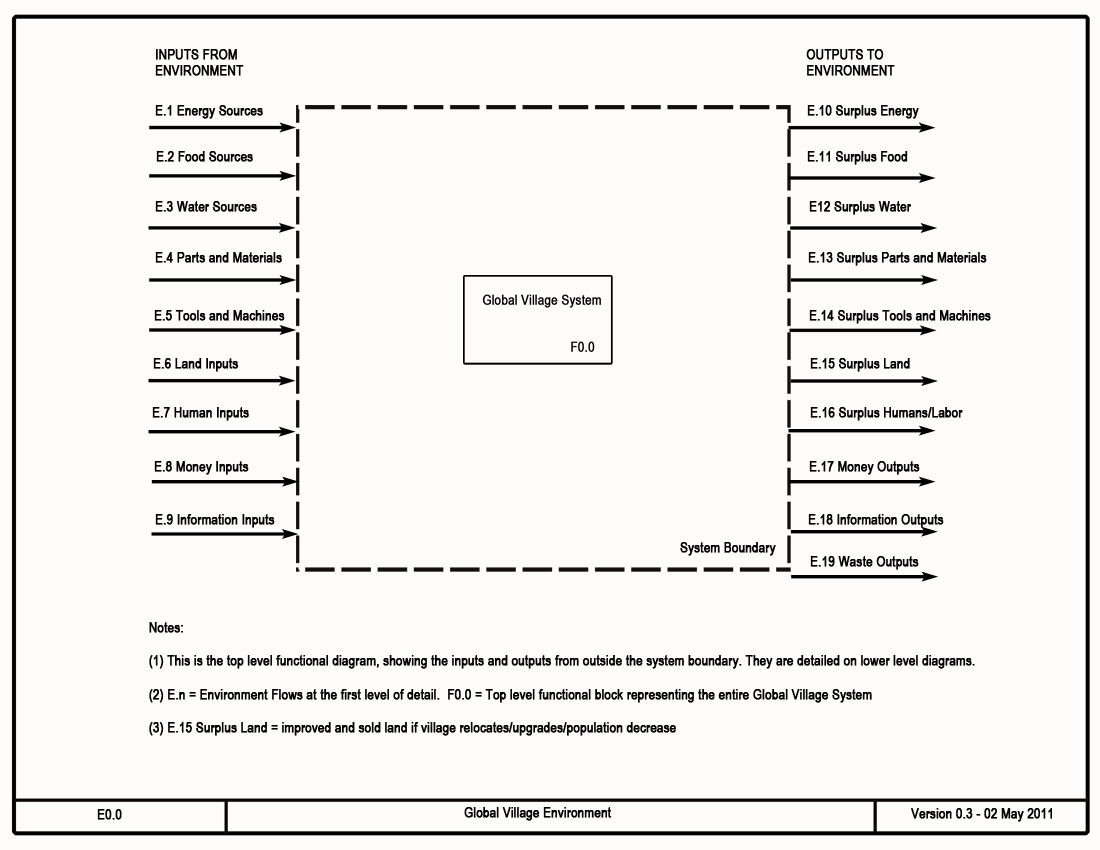Functional Block Diagram E.0 Environment: Difference between revisions
No edit summary |
|||
| Line 3: | Line 3: | ||
[[File:Block_Diagram_0.0_Environment_V0.1.jpg]] | [[File:Block_Diagram_0.0_Environment_V0.1.jpg]] | ||
===Notes=== | |||
* See diagram for notes 1-3 | |||
===Description=== | |||
The '''Global Village System''' is a combination of people, information, equipment, and facilities (land, buildings, etc.) which together provide for the needs of its people in a sustainable and growing, improving fashion. | |||
The system has a large number of interactions with the external environment, i.e. everything outside the system. The diagram shows the highest level of interaction as flows numbered E.1 to E.19. These break down to more detailed items on lower level diagrams: | |||
E.1 Energy Sources includes: sunlight, wind, wave power and stream energy if available, and commercial electricity. Commercial electricity may be balanced with E.10 Surplus Energy over time if more is produced than needed. | E.1 Energy Sources includes: sunlight, wind, wave power and stream energy if available, and commercial electricity. Commercial electricity may be balanced with E.10 Surplus Energy over time if more is produced than needed. | ||
Revision as of 12:52, 11 May 2011
Diagram and Notes
Notes
- See diagram for notes 1-3
Description
The Global Village System is a combination of people, information, equipment, and facilities (land, buildings, etc.) which together provide for the needs of its people in a sustainable and growing, improving fashion.
The system has a large number of interactions with the external environment, i.e. everything outside the system. The diagram shows the highest level of interaction as flows numbered E.1 to E.19. These break down to more detailed items on lower level diagrams:
E.1 Energy Sources includes: sunlight, wind, wave power and stream energy if available, and commercial electricity. Commercial electricity may be balanced with E.10 Surplus Energy over time if more is produced than needed.
E.2 Food Sources includes: nutrients for humans, livestock, and plants, seeds, and new livestock. Food inputs may be balanced with E.11 Surplus Food over time if more is produced than needed
E.3 Water Sources includes: rain, streams, and public water supply. Well water is not an input from the environment, it is part of facilities.
E.4 Parts and Materials includes: premade parts and basic non-food materials including bulk rock, soil, compost, sand, wood, metal, glass, etc. It also includes consumed items such as lubricants.
E.5 Tools and Machines: Tools do not have internal power, machines do. This includes external transportation, bought tools, bought machines, and temporary use of equipment by rent, trade, or shared use.
E.6 Land Inputs includes: bought land and temporary use of land by rent, trade, or shared use.
E.7 Human Inputs includes: full time residents, part time workers, and hired contractors.
E.8 Money Inputs includes: contributed capital and sales of surplus/specialized items to others.
E.9 Information Inputs includes: OSE plans, instructions, software, and upgrades, data connections and active data flow on the connections.
Links to Related Diagrams
Higher Level: None, this is the top level
Inputs: (To be done)
Outputs: (To be done)
Controls: (To be done)
Mechanisms: (To be done)
